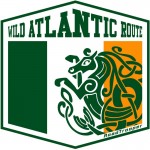 This is the first chapter in my Wild Atlantic Way Motorcycle Touring Guide, in this section I’ll be giving you an overview of what to expect from motorcycle touring along Ireland’s west coast and the Wild Atlantic Way tourist driving route.
This is the first chapter in my Wild Atlantic Way Motorcycle Touring Guide, in this section I’ll be giving you an overview of what to expect from motorcycle touring along Ireland’s west coast and the Wild Atlantic Way tourist driving route.
First off, the Wild Atlantic Way, or Slí an Atlantaigh Fhiáin in Irish is a tourism trail that follows the Atlantic coastline from the north of Donegal to south coast of Cork. The 2,500 km (1553 miles) driving route passes through nine counties and three provinces, stretching from County Donegal’s Inishowen Peninsula to the southern town of Kinsale in County Cork on the coast of the Celtic Sea.
A large part of this route is most definitely closed to coaches and “difficult” for any large vehicle due to the small roads which I’ll get to later. But to get to the point, the best way to travel this route is by motorcycle for good reason.
Being Irish I may be a little biased in my opinion, but after 20 years traveling extensively throughout Europe on two wheels I hold one solid conclusion of this route. It is, without any doubt one of the greatest routes in Europe any biker can undertake, it is in fact world class.
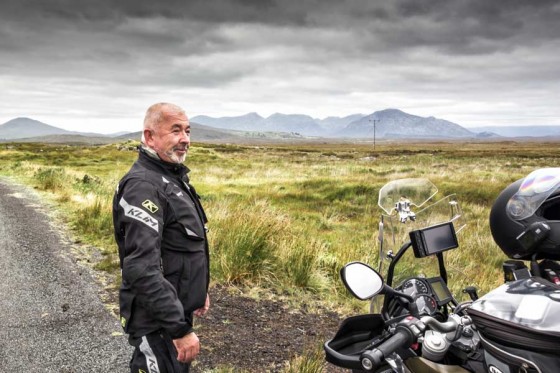
Myself – Somewhere in Connemara
Along with time honored pilgrimages to the Alps and Pyrenees Irelands west coast is utterly unmissable! From brutally rugged coastal landscapes and cliff’s carved by 20 meter waves to challenging and remote mountain back roads that never leave one’s memories is only part of the deal. From north to south the landscape never ceases to change, sometimes radically from the rugged Donegal coast, the magically mythical mountain views of the Connemara National Park to the unique limestone scenery of the Burren in County Sligo and brooding harsh mountainscapes of Kerry, but again this is just another part of the incredible journey. There is also the Irish themselves who have an inherently open, curious and friendly nature, always game for a bit of craic.
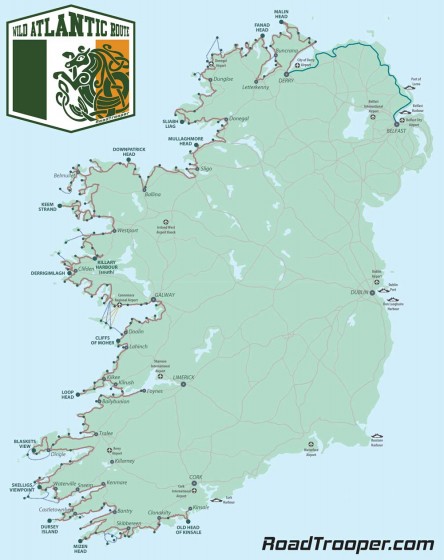
The WAW Map – 2500km – If you don’t go off-route !
It’s not so easy to describe the scenery of Ireland’s west coast but this video of one of my guided tours around Kerry might help get a proper picture in your head.
The Craic
One of the things Ireland is best know for is the pub culture. This character came about from Ireland’s mainly farming culture where the only focal points in small towns and communities for meeting ones friends and neighbours was either in church or in the pub. Often the village pub would double job by being a grocery or hardware store during the day and bar by night which is where the tradition of hanging old bicycles, kettles, farm tools or any old shite on walls and shelves. Up until the late 19th century village pubs were the only building that had a cold storage room, and so would also act as morgues for keeping the dead, so some bars were also the village undertakers. There is also the ancient tradition of “entertaining yourself and others” which has not been lost in Ireland, especially in the west. So if you do go for a quick pint and a chat in a pub you can often find yourself surrounded by traditional musicians (pre TV entertainment) whereupon one is infected by “the craic” and your “quiet pint” turns into what most foreigners would describe as an impromptu party, AKA – a piss-up.
Along Ireland’s west coast it’s a common occurrence, usually every Tuesday, Thursday, Friday and Saturday nights during the summer in the touristy towns. Eh, you might also count on a bit of a session on every other Sunday afternoon which can drastically affect your expedition unless you can keep a tight rein on your festivities.
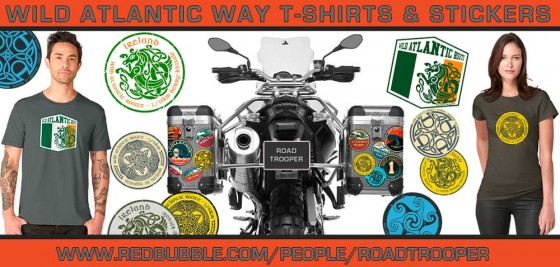
If this article is helpful please support this website by making a small purchase at the RoadTrooper Store. Click Image To Go To Store.
Eating Out
Even if you are of the tea totaling quite conservative persuasion the pubs are not to be avoided as many of the pubs house world class chefs lurking in wait to tickle your palate with gourmet food. The reason for this is the mountain landscape itself which makes industrial size farming in the west impossible. The rocky, mountainous terrain has now given rise to small farms specialising in organic foods and cottage industries offering produce of the highest quality to be found anywhere. From gourmet veggie burgers to hot/cold smoked salmon and hams, organic mussels and fish, it’s all produced here and of exceptional quality. As an ex-chef myself and a fussy bastard when it comes to food I assure you that visiting the area for the food alone is a worthwhile endeavor.
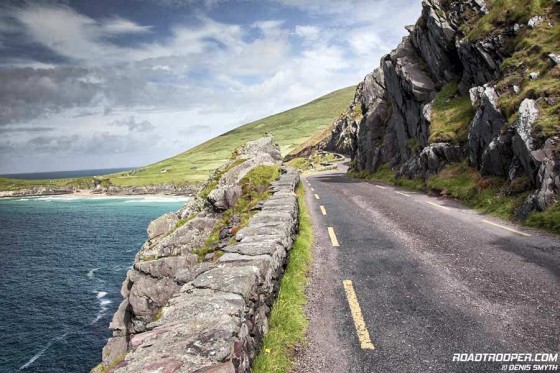
Slea Head Drive Dingle
The lush rich soil and grass has a lot to do with the quality of the food, and a good example of this can be seen, and tasted on the Dingle Peninsula. Once a rocky and barren landscape Irish peasants forced out of of the far more fertile land in the east by the English transformed this peninsula. Now known for it’s 40 shades of green the soil on Dingle and elsewhere was created by peasant farmers dragging countless tons of seaweed up into the hills where the now lush grass springs from a rich mix of seaweed, sand and peat.
Local Dairy
Here one of the local specialist farms is blessed by the Kerry Cow, an indigenous and rare breed. In fact there are more giant pandas then there are Kerry Cows, the locals prefer the Kerry Cow to the panda however, probably because it’s far easier to milk. With that in mind I’ve little doubt ye won’t mind taking your pallet for a stroll into Dingle town to let loose your inner child in Murphys Speciality Ice Cream Parlor to try a lick of the Kerry Cow for yourself.
Seafood
Seafood also takes up a large chunk of real estate on most menus, again thanking to the landscape which lends countless coves and safe harbours for the brightly colored fishing boats. Some chefs will simply drive by the harbour on their way to work to hand pick the catch for the evening menu. So when the menu says “fresh fish” it should not be out of the rich atlantic waters for more than a few hours. If in Westport don’t miss an opportunity to order a bucket of locally farmed fat and tender mussels cooked in white wine, cream and leek in the Tower Bar & Restaurant down on the Quay. I highly recommend ye wash down this massively proportioned starter or main course with a liberal dose of Donegal Brewery’s Atlantic Amber Ale before the band kicks in and you find yourself talking to strangers – again lol…
Points of Interest Along the Way
Along the route there are places and attractions which have been designated as points of interest for travellers. Some inevitably are tourist traps designed for normal folk, i.e. the poor sods driving cars or camper vans packed full of kids and in-laws which the average motorcyclist may well want to avoid. But if taking this route on a motorbike as Manannán mac Lir (Irish, Scot & Manx God of the sea, creator of the WAW) intended you get to experience far more than the average car or cattle coach plodding tourist.
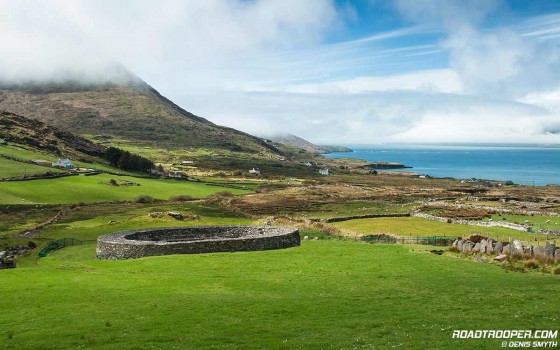
I found this view by riding down a tiny country lane off the Ring of Kerry. This POI is almost impossible to get to in anything larger than a small city car (and even then it would be difficult) making a motorbike the ideal tool for exploring the WAW.
The Slieve League Cliffs for example, rising 2000 feet / 600 meters offering unmissable views over Donegal Bay to counties Leitrim, Sligo and Mayo to the south. Near by at Carrowmore lies one of the largest and oldest known Neolithic cemeteries on the planet. From the top of Slieve League can be seen the island of Inishmurry home to early Celtic Christian monks and near the staging point for the monks passage to Iceland to turn those Viking louts from their heathen ways.
Further along the coast in county Mayo is the little port of Killala, scene of the French landings in 1798. Signal towers built by the British to warn of a return of a French fleet can still be seen here too. You may also notice “Eire” spelt out in painted rocks from the cliffs too. During WW2 the south of Ireland, while neutral, had agreements with the allies, one of which was the Donegal corridor. This was a free fly zone for allied aircraft to fly from Enniskillen in Northern Ireland out over the Atlantic. The word Éire was placed in stone on headlands around Donegal, to act as navigation aids, here on Sliabh League you can see one today beside the viewing point car park. It’s difficult for those with an interest in the past not to feel the weight of five and a half thousand years of historical facts being hurled at you throughout the whole journey.
History of WAW Route
In the last 6 years or so since the rebranding the western coastal roads have been upgraded with WAW Route signposts liberally planted along the way so the mapless tourist won’t get lost. Wonder off the route however and you better have a SatNav or a good map because the rest of Ireland is still devoid of proper road signs. This is partly due to the Irish Governments in-ability to give a shit and teenagers wandering out from the pubs after closing time, or from the fields after picking happy mushrooms and thinking it a good idea to rehouse the said signposts in their bedrooms. Sign post collecting is a popular passtime for many Irish teenagers, I should know as I once had a fine collection of signposts myself.
The west of Ireland has changed little since my parents brought me as a witless kid on our summer holidays over to the west coast. The only real change has been some serious upgrading of the motorway network. Back in the day the drive from Dublin to Baltimore on the south west coast of Cork could take 9 hours or more, it can now be done in 5 hours if you take a liberal view of the national speed limit and skip lunch. Unless of course you try driving there on the June or August Bank Holidays in which case your back to a 9hr drive or 7 on a motorbike.
A major increase in tourists, camper vans and cattle trucks (coaches) is another fairly recent change. In July and August the west coast is plagued with them as it is in the rest of the more popular spots across western Europe. But Irelands west remains a rural area and therefore underdeveloped, not many people actually live on the west coast due to the lack of jobs outside of farming, fishing and tourism. This is a good thing from a visitors point of view and the main points of actually coming here.
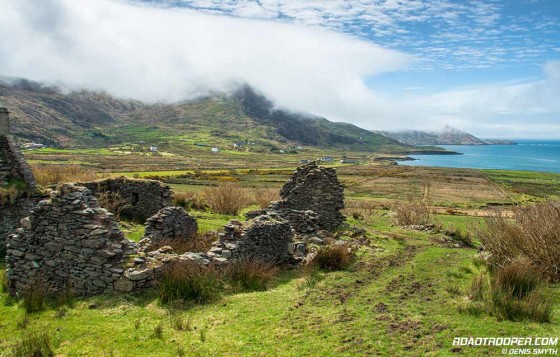
Irelands shoreling is blissfully free of ugly towering hotels. The west coast is a highly protected area and planning permission for anything is very difficult for non locals.
Being underdeveloped it retains it’s wild, empty rugged nature and the absolute opposite of the ruined French and Spanish Mediterranean coasts destroyed by ugly high rise hotels and apartment blocks. So, Irelands lack of this type of development makes booking hotels, B&B’s etc essential well in advance of your trip during high season, at least 6 months in advance. If riding solo you’ll be fine, there are plenty of small B&B’s down many country lanes. But for popular towns like Dingle or Killarney you’d be well advised to book 1 year up front if you want a hotel in August and most especially if riding in a group.
Best Time to Ride WAW Route
For my money the best time to ride this route is from late March to mid June and September to mid November. July and August is likely to see the warmes weather but it’s obviously far busier and you are sill just as likely to get wet. It’s also easily possible to ride it from December to February as snow is rare along the coast, but there are some amazing routes through the mountain regions which can easily be off limits during the coldest months due to snow or ice. December to early March will see some proper Atlantic storms blow in and some small roads closer to the sea may simply disappear. You’d be surprised at just how much damage a full blown Atlantic storm can do as it pounds 15-20 meter waves at the Irish coastline. Taking a stroll down a pier or along the western beaches during one of these storms is a sure fire way to tempt fate or commit suicide. Many tourists, and locals over the years have also misjudged the force of the wind while walking along the 100’s of kilometers of remote and fenceless cliff walks with lives sadly lost every year.
The Cliffs of Moher have claimed many an unwary tourist. Children in these areas are brought up hearing stories that these places are home to malevolent fairies that will drag them out to drown in the sea if disturbed. Such stories sound like romantic nonsense like leprechauns and the like, but they were tolled to scare the kids from going too close to the cliffs or sea. So, consider yourself warned or face the wrath of the sea fairies and stay the hell away from the coast during an Atlantic storm! Unless of course you’re a surfer, in which case you will be in a world class location to ride the monster waves thrown forth from the massive Atlantic swells..
The posted “official” route is aprox 2,500km and hugs the coastline. The reality is much of the roads are narrow, windy one track affairs and are very slow going, I’d not plan on covering much more than 250km-300km per day max. However, while the roads are little more than boreen tracks the views of the atlantic, tiny coves, islands and coastline are simply breathtaking and few places in the world can offer so many reasons to stop and stare. My prediction of 300km per day is dependent on you not stopping at every opportunity to pull out a camera and taking 2hr lunch breaks. There is also another upside of these tiny one track roads, there’ll be few cars, fewer campervans and no sheeple coaches blocking your way along, and even in mid summer you’ll find deserted coves and beaches to explore. The boreens however are slow going, engine size matters little and smaller, more nimble bikes will win the day and average speed will be around 30kmph.
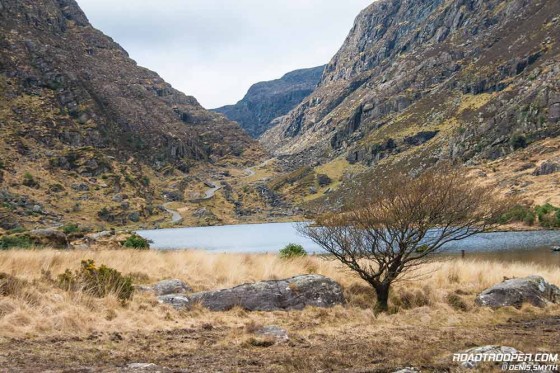
The Kerry mountains are not on the WAW route, butyou’d have to be mad to miss an opportunity of riding through the Gap of Dunloe or the Black Valley?
I really don’t think anyone can possibly get the most of the WAW in less than 3 weeks as there is so much to see, do and ride. I can’t stress enough the fact that the official coastal route is only part of the ball game. The optional mountain roads along the WAW route are for me as a motorcyclist of equal pleasure and in many cases more-so. For this reason the Wild Atlantic Way is simular to the Alps. I think most bikers who have ridden in the Alps, or Pyrenees will agree that just one visit will never be enough. With this in mind, unless you’re lucky enough to afford a month on the road don’t try to see it all in one trip. It’s best to split it into two sections, the southern section, Kinsale to Killary Harbour, and the northern section being Killary to Mallin Head and Derry + 2 days for Northern Irelands Causeway Coast. In the following guide I’ll break it down further starting in the north, e.g. Donegal to Sligo, and each with various route options taking in the official coastal WAW route plus my own perfered or alternative mountain routes which I hope will give you a good base for planning your own trip. Each route is available to download as .GDB or .GPX in the download page.
More than once I’ve chatted to fellow bikers where I’d ask, “have you ridden the Route des Grande Alpes?” Inevitably and inexplicably some would boast that they rode the full route from Lake Geneva to the French Riviera in 2 or 3 days!! Sadly I’d can’t help think to myself, “ well done, you’ve been to the Alpes but seen and experienced almost nothing! Outside of an enduro rally, in motorbike touring terms I’d call this a missed oppertunity! The Wild Atlantic Way is no different so the best advice I can give is slow down and take the time to look around and get off the beaten track as many of the mountain roads are as brilliant as those along the coast.
Ride Through The Gap of Dunloe, Killarney, Co. Kerry, Ireland
One of the main reasons I’m spending my time with this website is so fellow bikers don’t fall into the trap speeding along the fast lane. Riding the world is one thing, but truelly seeing, and experiencing the world is something completely different. Our world is constantly and rapidly changing, rarely in a positive way. Riding a motorcycle of any shape or form is one of the most amazing ways to see our world before it’s all flushed down the corporate toilet. Modern life trains us as tourists to see more and spend more in the fastest way possible, I’d urge you to take a breath and slow down for the Wild Atlantic Way. Irelands west coast is one of Europes few bastions of wild, unspoilt areas full of ancient history and tradition left in western Europe, the Alps, Pyrenees, Picos, Northern Scotland and Scandinavia being its only real rivals. But unlike anywhere else, you’re as likely to enjoy it just as much on the back of a simple moped as you are on a 1200GS Adventure.
Practical Advice
On the road…
If you see an oncoming car flashing their lights at you it usually means there is an accident, speed trap or potentially dangerous obstruction ahead. A motorcyclist will instead likely wave his/her left hand/forearm up and down indicating you should slow down immediately ahead. A quick “one” flash of their headlights or a side tilt of the head means they are just saying hello. They might also shake a leg at you ![]()
There will be 2 main classification of roads you will face outside of towns and motorways:
- N – National roads, e.g. N17 speed limit 100kmph, expect all and any type of traffic which can be very heavy nearing large towns like Killarney, Galway etc. Usually well maintained surfaces with fair road markings and signage. Many corners can be deceptively tight, be wary of sheep and especially farm equipment in rural sections. Beware of mud and shit near farm and field entrances. Mobile speed traps are now a common nuisance.
- R – Regional roads, e.g. R551, speed limit 80kmph, these can be well maintained roads between towns in which case you can make good headway but expect all and any traffic, inc. sheep and the same dangers as above.However these (R) roads can also be rough mountain single tracks with traffic jams caused by sheep, cyclists, tractors etc. Even if they are traffic free a posted speed limit of 80kmph would seem optimistic due to the nature of the road with an average speed of 40kmph more likely. Distances on these roads can be very deceptive so don’t plan on covering big miles quickly. It’s impossible to tell by a map or SatNav how fast you will actually be able to travel on these roads even if traffic free. Additional dangers include severe potholes, deer, gravel, water run-off, flooding, milk tankers, stray dogs and hippies. Some mountain roads may close or be highly dangerous due to snow or black ice in winter.
Note:
Not all the roads are rough, far from it as the rough sections are well mixed with beautiful smooth EU funded roads none of which are straight for long periods and perfect for any motorbike.
(!) Very Important:
The Irish are used to narrow roads and “usually” take into account potential oncoming traffic on narrow roads with blind corners. However, many R roads on tourist routes like the R559 on the Dingle Peninsula need extra care where coaches are a big problem for bikers. On these very narrow roads you will often come around a blind corner only to face a coach taking up the whole bloody road. Most Irish coach drivers are well used to these roads, are sympathetic to cyclists and bikers alike and drive accordingly. Foreign coach drivers however are a different matter entirely. They are unused to driving on the left and are unaccustomed to the narrow roads and it may seem that they are intentionally targeting you for execution. Foreign RV drivers aren’t much better with the Spanish, Italian and French drivers being the worst offenders – by far! I’ve had many close calls with these guy’s, especially with my metal panniers making my F800GS as wide as a small car. It was specifically for this reason that I choose soft 30ltr panniers for riding Irelands west coast, rural and mountain roads.
Top Tip to avoid the cattle waggons of death and stay safe:
On R roads like Dingle’s R551 and the Ring of Kerry the coaches tend to drive from the south to the north on the left hand side of the road. This is to allow the cattle, eh passengers the best view over the cliffs to the sea views. So, if you want to make headway it is sometimes quicker to ride from the north heading south to avoid the bulk of the tourist traffic. As a motorcyclist you will have many more opportunities than cars to pull across the road to enjoy the views and take photos. Either way, be extra cautious, on these roads speed and inattention WILL be the major factor in traffic accidents. Be mindful, just because the posted speed limit is 80km/h it does not mean that it is safe to do so as you will also have potholes, gravel and mud to deal with as well as other road users that are distracted by passengers or the views. Unlike the UK or the continent there will be many more American drivers who tend to be nervous being very unused to dealing with the narrow roads as well as driving on the wrong side. Matters will be made worse if the car rental company gave them a manual (stick shift) drive instead of an automatic more common in the US. Because of this I’ve found it safer to give myself a little more braking space between me and the car ahead in case they slow quickly (driver hits wrong gear) when you least expect it. City drivers may also needlessly slow down, or swerve sharply to the right for roadside sheep which you may not see, so like I said, there is any number of reasons to give yourself and extra 2-3 meters braking distance more than you may normally do at home, and never overtake another vehicle if there are sheep on either side of the roadside ahead. Nine times out of 10 the sheep will ignore traffic and carry on with their business, but it only takes one stupid wooly fecker to make a nervous tourist swerve or brake quickly to ruin a perfect day, and on Irelands “R” roads there is little room to make emergency maneuvers.
What’s the best type of motorcycle to ride the WAW route?
Any bike will do the job. If you’re going to follow my routes which include mountain sections I’d recommend a mid sized adventure style bike as the ideal choice. I found the F800GS the perfect tool for the job with it’s narrow profile, high upright seating position, with it’s off-road’ish suspension perfect for soaking up the rougher roads. 1200 GS/Adventure and R1200RT type bikes are also perfect for the job, but the size and weight will get very annoying for some on the boreens and many back roads. As many of the roads are small, one track as as good as any big bike will loose it’s advantage over more learner friendly bikes for example.
Anyone looking to do the full route on a sports bike is sure to get pissed off at some stage, it’s obviously easy to do but on many of the roads along the route an old single F650GS will be faster and far more practicle than a S1000RR. I’ve ridden much of the WAW on a F800R which is a road-only bike which was excellent for the most part. But my wrists and arse suffered on the rougher roads and my DSLR was also destroyed even though it was well padded in the top box. I’ve also ridden the route on a Kawasaki Vulcan VN800A (Jap type Harley) and thoroughly enjoyed it, although unsurprisingly enough the suspension and rear shocks got a battering and the exhaust inner header pipe broke off where it enters the engine which made the ride home shockingly noisy. However the roads have improved a lot since that trip on the VN. For this trip small is good, for this reason the WAW is an excellent choice for a young rider on their 1st big trip to get a taste for motorcycle touring. Remember, not all the roads are rough, far from it as the rough sections are well mixed with beautiful smooth EU funded “N” roads none of which are straight for long periods. So if the boreens or “R” roads are slowing you down, or pissing you off for any reason it’s easy enough to pull out and join a main road. Therefore, if planning to ride in a group of mixed bike styles make sure everyone knows how to get to the nights accomodation to allow others in the group to choose their own road preferences as the roads/bikes dictate. To get an idea of the road types you can watch the vids I’ve uploaded to my YouTube Channel. I was pleasently surprised during my last trip 2014 to this region how good the roads actually were, even large sections of mountain back roads beautifully smooth and better than many I’ve ridden in France or Spain lately.
Fuel
Generally petrol stations are easy to find. Most mid sized villages will have one either in town or just outside. On “N” roads you will find them easily, but as unlikely as it seems, Irish motorways dont have them and you will need to ride off the motorway to find one. So if you’re riding the Dublin to Galway or Cork motorway be sure to fuel up before leaving the “Big Smoke” – Dublin. Large areas of Connemarra and most mountain regions are uninhabited so fuel stations also run a little thin in these areas.
Weather
July and August are the warmest months (15-25 degrees C) and winters are generally mild (6-10C) due to the Gulf Stream. Ice and snow along the coast is rare and never lasts for more than a few days but can linger on high ground. In winter Atlantic storms with high winds may make riding highly dangerous for 24-48 hours in exposed areas. Packing good rain gear is absolutely essential at any time of the year. A mid level base layer or fleece is also essential in summer. Don’t bother bringing sun screen, if ye see someone with a red face it’s more likely to be from the drink or high blood pressure from too many Irish breakfast’s.
Atlantic storms can roll in at anytime. If you’re staying overnight near the sea or in an exposed location it’s a good idea to try and remember this and park your motorbike behind some kind of sturdy shelter. A 40kmph wind can easily gust to twice that speed to blow over and damage even the heaviest bike, and driving rain or salt water spray can get up into the electrics of a bike causing all sorts of trouble.
Cost
Accommodation ranges from €15-€25 for a campsite or hostel. €25 to €65 for a B&B, €50 to €80 for a 2 / 3 star inn or hotel, €80-€130 for a 4 star. In Ireland all prices including accommodation, food etc. are inclusive of tax and usually includes a good Irish or Continental style breakfast.
Wild camping is legal in the Republic of Ireland but private, government body (e.g. ESB Electricity Supply Board) and military grounds are obviously off limits and can result in a heavy fine. Some areas of the national parks allow camping (check first) but building camp fires or lighting BBQ’s is almost always prohibited. A “No Camping” “Private” or “No Public Access” sign will usually be in view in those areas. Most farmers will also happily allow you to camp on their land as long as you ask before pitching up camp. This is very important to do as some cattle farmers may have a bull on their land and you will need to know which field to stay well clear of as they can be big and highly aggressive, the bulls even more-so. You should also be aware that Irish home and landowners can legally shoot anyone who enters their property posing a threat under a “reasonable force” (Defence and Dwelling Act 2011), and as most Irish farmers own a gun it’s ill advised to pitch a tent without asking for that reason alone. Remember, most farmers are happy to allow camping if asked, if they do refuse it’s often for safety reasons (bulls) and especially during harvest season when outside contracters with large heavy machenery may access the land at anytime and will not be aware of your presence.
Ireland enjoys a tourism (and related activities) VAT tax rate of just 9%, this is the tax you pay for tourism related goods and services within the country. This includes accommodation, hotels, B&B’s, campsites, food and drink (excluding alcohol, cigs etc) and as stated above will be included in your bill and also inclusive of the price shown on restaurant menus. The 9% VAT (Value Added Tax) makes a trip through Ireland very good value, while the price for food and accommodation may be comparative to the rest of Europe the standard is generally higher, if not exceptional. For example many similarly priced 3 star hotels or B&B’s in Ireland may often be of far higher standard than those found in France or Spain. The same applies to restaurants.
In Ireland most restaurants must be of a high standard these days as the Irish now see themselves as gourmet foodies. It’s not uncommon to see a couple of manly lads in dirty overalls at a bar arguing over how best to cook a pheasant. If a chef can’t cook better than his clientèle then God help him. The Irish are also completely addicted to complimenting or complaining on review site’s like Tripadvisor.com, so if you want to know what a hotel, pub or restaurant is like before you go simply check out Tripadvisor.com or Booking.com.
Getting on with the Irish
The Irish love to talk to foreigners or strangers and can happily strike up a conversation with a lamp post. If stopping someone for directions in a rural area it’s usual for the Irish to first strike up a short conversation (usually about the weather – a national obsession) before diving in to ask a specific question.
In Irish pubs it’s generally accepted that if you sit down at a table it means that you want to be left alone, or to eat which is essentially the same thing. Sit at the bar however and it’s accepted you are open for a chat with the locals, and/or thirsty with intent and want be as close to the beer tap as possible.
Some bars may have a specific corner in the sitting area for wandering musicians, there may be a plaque “Musicians Corner”. You are better off not sitting here as you will be expected to move if musicians pop in to play a reel, feel free to buy them a pint in return for a few requests.
When chatting to the locals in a bar it’s best to steer the conversation well away from politics, the Irish are very well read and educated, they may easily know far more on the subject then you do, especially history and current world politics. A huge proportion of Irish families have a son, daughter or cousin (sometimes the majority of the family) working abroad, so they know well what the real story is and not the government sanctioned utter bollox shown on Sky News.
The Irish won’t really give a rats ass what race, color, sexual persuasion or religion you are (as long as you’re not looking for a job lol). Although once they get to know you, you may face the national hobby of “taking the piss”. This is an art form in Ireland and involves the contestants making light hearted fun at the others expense with the quick witted and those most verbally creative winning the contest. Best to just have a laugh and don’t take it personally as the first person to get upset, frustrated or mentions the opponents blessed mother in a poor light loses.
If you are planing to stay in the Irish speaking areas and you want to give a really good impression to the locals a fine way would be to learn a little Irish. Everyone will be happy to speak English so you only need to know the very basics.
Hello = Dia dhuit (DEE-a GHWIT) [Shortened form of, 'Go mbeannaí Dia dhuit', literal meaning is, 'May God bless you'] – the response to this greeting is
Dia is Muire dhuit (DEE-a iSS MWIRR-a Gwit) [literally (May) God and (The Virgin) Mary bless you]
How are you? = Conas atá tú? (CUNN-us a-TAW too?)
I’m well = Táim go maith (TAW’m guh MAH)
What is your name? = Cad is ainm duit? (COD iss ANNim ditch?)
My name is John = John is ainm dom (John iss annim dum)
Nice to meet you = Deas bualadh leat (JAHSS BOO-loo lyaht)
Please = Le do thoil (singular), Le bhur dtoil (plural). (LE do HULL, LE wur DULL)
Thank you/you (pl.) = Go raibh maith agat/agaibh (GUH ROH MAH ug-ut/ug-iv)
You’re welcome (in response to ‘thank you’ = Go ndéanaí mhaith duit/daoibh (singular/plural). (“Goh nyae-nee wah ditch/dee-iv”) or : Tá fáilte romhat/romhaibh (TAW FOIL-chyeh ROWt/ ROW-iv)
Yes = Sea (SHAA; note that there is no real translation for yes and no in Irish – the words here literally mean ‘it is’. People usually use the question verb again in their replies, in the positive or negative, in the same tense, voice and person as the question was asked.)
No = Ní hea (Nee haa; literally, ‘it is not’)
How to get there & where to rent a bike?
Ferry:
- Dublin Port – UK, Isle of Man and France
- Dun Laoghaire – Holyhead (Wales UK)
- Rosslare – France, UK
- Cork – France
- Belfast – Isle of Man, UK
Airports to Fly & Ride
Dublin Airport and Shannon Airport – Celtic Rider Motorcycle Rental & Tours Ireland. Celtic Rider Motorcycle Rental & Tours Ireland is officially approved by Tourism Ireland and Failte Ireland. Located close to Dublin Airport they can arrange for airport transfers. Bike gear also available for rent. For more info see Rental stations in Dublin and Shannon, both international Airports for North American and Canadian tourists.
Belfast Airport – Phillip McCallen Motorcycle Rentals, 30 mins from Belfast, less than 2 hours from Dublin and offers airport transfers. For more info see
Phillip McCallen Motorcycle Rentals website
Killarney – LemonRock Motorcycle Rental Based at the Brehon Hotel 20mins from Kerry Airport and the only business directly associated with myself as I have been working with LemonRock designing their self guided tours and will be working with them from time to time as a guide. Contact myself for custom tours or the lads directly to book a shiny new R1200GS, R1200R, F700GS or my favorite the F800R, for more info see LemonRockBiketours.com
Note: I am not associated in any way with any company or business held within this guide – with the exception of LemonRock.
Read Next Post – The Wild Atlantic Way for Bikers, Donegal to Sligo »
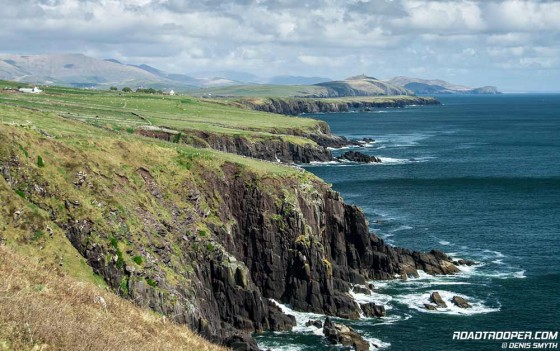
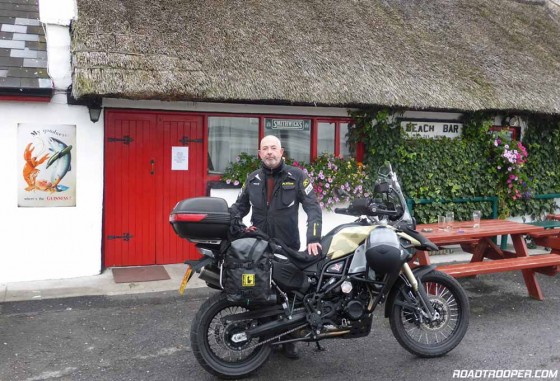
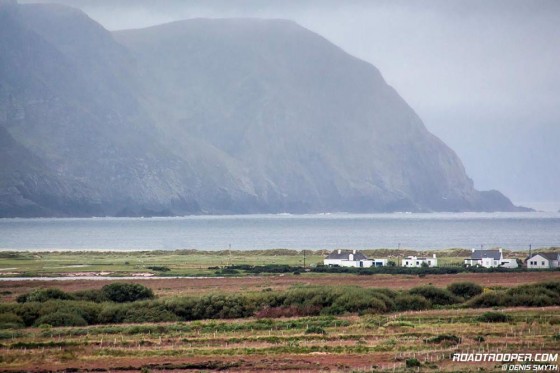
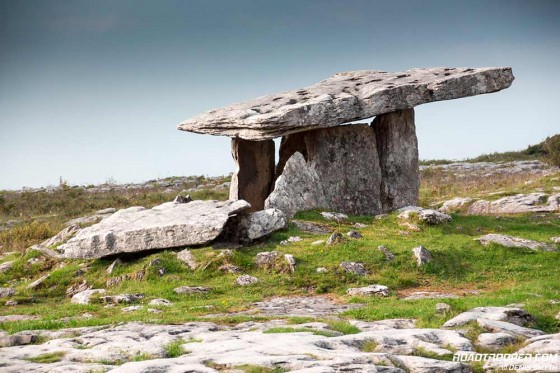
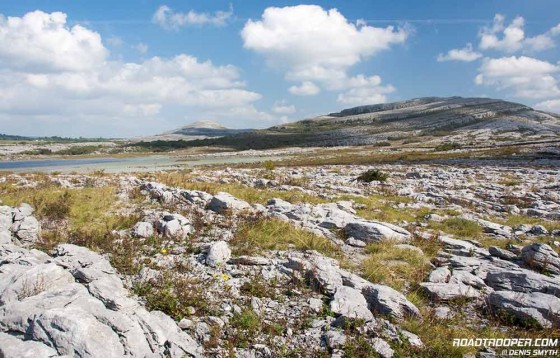
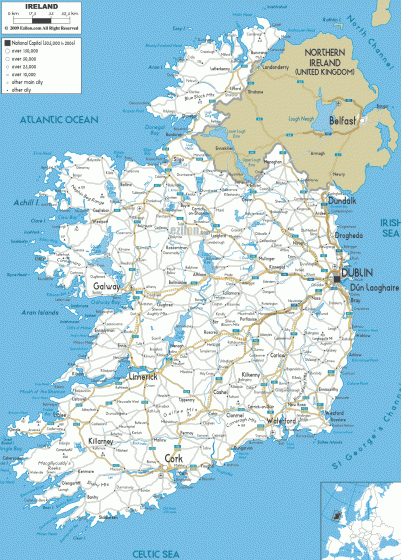
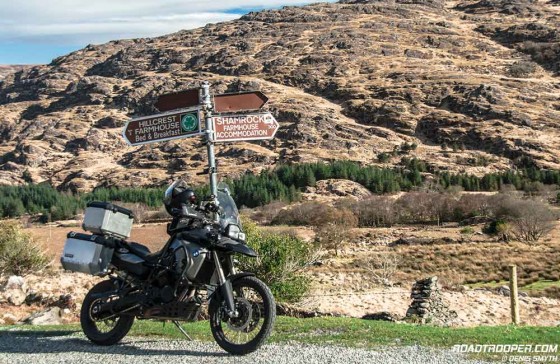
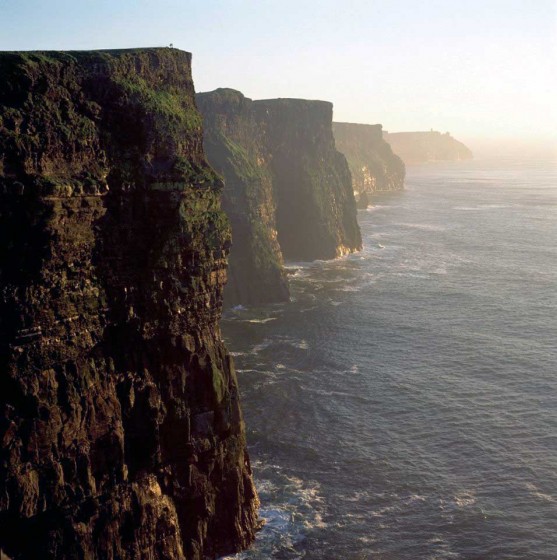

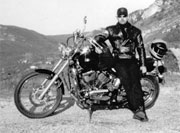







Dear Dennis,
As I am planning to cycle the WAW in May, I have been lucky to stumble into yr article, which answers most of my questions.
Though I am in search of 1 thing I can’t find : the GPX coordinates file for the route to use on a GPS. Would you happen to have such a file for the WAW, and if so, would it be possible to share it with me ?
Thank you so much for letting me know, and I really hope to hear from you soon !
With warm regards from northern Belgium,
Ferre
Hi Ferre,
The full route can be downloaded as .gpx or.gdb from the GPS download page (http://www.roadtrooper.com/download-gps-routes) You will need to register to access them but it’s free. The route is broken down into “county” sections – Cork, Kerry etc. Within each download you’ll also find the official coastal WAW route plus alternative mountain route sections which are a little more remote but offer less traffic and equally amazing scenery. Let me know if you have any problem accessing them at denis.smyth@roadtrooper.com and I’ll email the routes to you.
Rgds
Denis
We are a year further down the line, and still prepairing the trip, which will take off of next May 3rd in Donegal. I hope that 10 days on the road will be sufficient to lay back the whole WAW. I will come over with my own bike, F800GS.
Sorry I did not thank you last year for your help, which I will do now via this way : your info proved to be of great help, and I have managed to download the routes (and convert them to use on my TomTom rider). Thank you again for your input.
Hope to meet with you one day !
Ferre – Belgium
Hope you have a great time along the WAW, the F800GS is the perfect bike for this route. I’ll be back in Killarney after from the 9th of May, so if you are in the area let me know and we can meet up for a ride or a few pints
Denis
Top post. I’ll be taking a long overdue trip to the Isle at the end of May – beginning of June. Got some off roading to due in Wales first. Shame I sold the G650x looks like it would be perfect for the Irish roads. As it is I’ll be on a 950 Adventure
The mountain route via the Gap of Dunloe seems cool. Is that advised rather than the coastal route to Killarney?
Are there any gravel or unsealed road section to enjoy along the route anywhere?
Cheers
Hi Mike, sorry for the very late reply, I was away for s bit then completely forgot.
Personally I really prefer the mountain route over the coastal route. The coastal route is a beautiful and mostly relaxing ride if you don’t get stuck behind a string of coaches. As you are coming in late May the tourist traffic will be starting to pick up with the Ring of Kerry being tourist central. The mountain route mostly consists of in track roads, some are smooth, some are of the rough variety with grass growing down the middle. The scenery along these roads is often spectacular, very much like the Scottish Highlands but more remote. Very few tourists find their way up there and I’d say it’s perfect for any dual sport adventure bike a GS or your 950 Adv. The mountain route demands far more attention for a safe ride and between that, the scenery, the remoteness and lack of traffic I really enjoy riding there more than the main coastal road. There are very few opportunities for off roading on big bikes here. There are some mountain tracks but these are really suited more for proper off trials bikes, 125′s or 250′s. I think though you’ll really get a blast on the mountain roads or the less touristy peninsulas like Beara.
I’ll be in Killarney, so if I’m free I’d be happy to bring you round some of my favorite back roads for a day or two, I’ll take any excuse to get out for a ride. Drop me an email (denis.smyth@roadtrooper.com) and we might be able to meet up. If not have a safe trip, I’m sure you’ll enjoy it no matter which route yu take..
All the best,
Denis
Hi there, looking to ride the Wild Atlantic Way in May, which mapping software would you suggest I use. I can download the GPX data from here but not sure which maps to use.
Thanks for all the information contained on the site, it’s been really helpful
Regards Tim
Hi Tim,
There’s a number of free mapping software solutions you can use but the one I use which is very popular many folks is Tyre. Tyre is a route mapping software which uses Google Maps to plot the routes so the maps are always up to date and better than the Garmin maps. Tyre works equally well with Garmin, TomTom, generic .gpx and other SatNav file formats as well as Google Map/Earth KML and KMZ files. The basic version is free
to use. It also integrates with MyRouteApp and Sygic so you can use the .gps/.gdb/.itn etc files in Tyre for free and transfer them via MyRouteApp to your IOS or Android phone easily enough although.
Download Tyre: http://www.tyretotravel.com/
Hope this helps get you sorted,
Rgds
Denis
Hi Denis,
This is a great article and has whet my appetite for coming to Ireland on the bike, I am potentially going to be traveling with 3 other guys, I ride a Honda Crosstourer, 2 are on BMW GS’s and 1 rides an BMW RT 1250. We would be looking to spend a week riding round, some of us are not quite as young as we once were, with the oldest of us being 75. What part of your route would you think would be most suitable please?
Hi Ceiyates
A lot would depend on how many days you have to play with. The full WAW would take about 2 weeks. For the most part, and especially if it’s your 1st time visiting, I’d definitely recommend concentrating on the south/south-west. West Cork and Kerry have exceptional coastal and mountain roads and scenery, however some of the roads would not be suitable for an RT. I had an RT myself for many years, but there’s a fair few brilliant roads, particularly boreens (very rural roads) here that I’d bypass on a RT unless the rider is at expert level. But dont let that statement put you off in the slightest as you can still have an amazing trip. Given your criteria I’d highly recommend a weeks trip starting in Bantry (entry port Rosslare) and riding north via the Beara Peninsula Iveragh Peninsula (Ring of Kerry), Dingle Peninsula and County’s Clare and Galway through Connemara to Westport then scoot home via Dublin Port. That’s a trip you’ll love and likely want to do again in reverse Hope this helps. Drop me an email at denis.smyth@roadtrooper.com if you need any more info/help, cheers D..
Hope this helps. Drop me an email at denis.smyth@roadtrooper.com if you need any more info/help, cheers D..
Hi Denis,
Thank you for taking the time to respond. Sorry it has taken me so long to acknowledge. I am still looking and discussing with the rest of the group and will certainly email you with any further questions.
Regards Chris